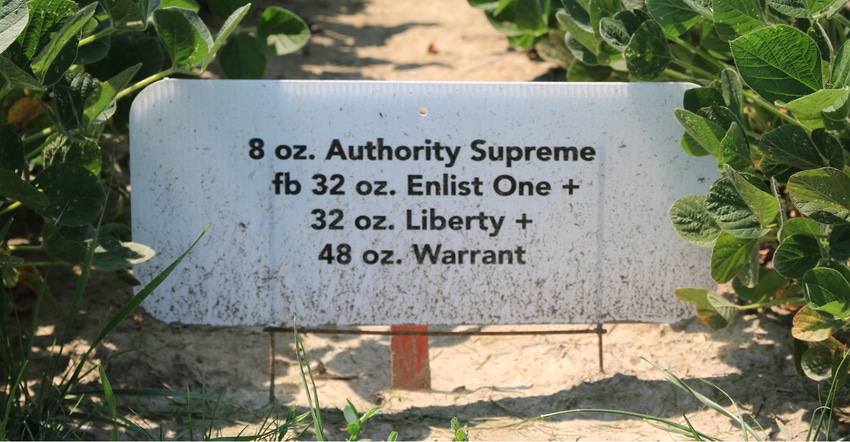
Options for controlling waterhemp and other problem weeds in Illinois are thinning, prompting weed specialists to investigate alternative strategies “outside the jug.” The goal: to take pressure off the trait platform a farmer uses by preventing more weed seeds from being added to the seed bank.
Tactics include not destroying a herbicide barrier with tillage, or deploying cover crops and using narrow row spacing, says Joe Bolte, herbicide specialist and Practical Farm Research technician for Beck’s in Effingham, Ill.
To avoid relying on postemergence herbicides too much, Bolte says growers should develop strong preemergence and residual control. And in the wake of the appeals court ruling that vacated three dicamba labels in June, farmers are looking for more and better options to control glyphosate-resistant waterhemp.
Residual control
Postemergence options for waterhemp in soybeans can be limited depending on the type of resistance weeds are showing, making residual control with groups 14 and 15 herbicides more important.
With both residual and post activity, Warrant Ultra includes the Warrant Group 15 herbicide, as well as the PPO inhibitor and Group 14 herbicide fomesafen.
“Warrant Ultra gives you an option on emerged glyphosate-resistant waterhemp that escape, but it’s not foolproof. Some waterhemp populations are resistant to PPO post herbicides such as Cobra and fomesafen,” Bolte says, noting control may be limited in heavy-pressure scenarios or if plants become too large.
He says Warrant has effective residual control on PPO- and glyphosate-resistant waterhemp.
Bolte’s experience has shown power in the preemergence application. “Regardless of what trait platform you use, preventing weeds from emerging early on is important,” he says.
At the Beck’s demonstration site in Effingham, Bolte and his team plant flags as weeds emerge across dozens of different strip trials, with different colors assigned as a given residual passes its window of efficacy.
“We recommend using a preemerge herbicide with at least two effective sites of action,” Bolte says. “If you only use one, then having an in-season-applied residual becomes even more crucial.
“When you apply two to three sites of action upfront like we prefer, you can see that an in-season residual isn’t as crucial, but we still recommend it.” He points to an Xtend soybean strip mostly clear of flags that received a preemergence application with three sites of action.
Dicamba products such as Engenia have postemergence and soil activity. When paired with an approved preemergence tank-mix partner, Engenia resulted in fewer flags compared to a one site-of-action preemergence option and no Engenia.
“This shows that the more effective sites of action you have, the more effective your weed control gets. That applies to every trait platform,” Bolte says.
Strip trials
He walks a strip of soybeans that received a postemergence application of Roundup PowerMax and Warrant without a PPO inhibitor added in. The strip has waterhemp pressure because the weed is resistant to glyphosate.
Warrant doesn’t offer postemergence activity, so it had no effect on any of the waterhemp that had already emerged earlier in the season. However, Warrant’s residual activity is very effective at reducing new waterhemp emergence in-season.

OVERGROWN: In a strip trial of glyphosate-treated soybeans, glyphosate-resistant waterhemp grows unchecked.

“Warrant Ultra could have helped in that case,” Bolte says. “For susceptible plants, when a PPO postemergence herbicide such as Flexstar [fomesafen] or Cobra is used, we see greater success if weeds are smaller.”
He says the ideal herbicide package includes an initial blanket with a preemergence herbicide that has two to three sites of action, and then an in-season residual applied 21 to 24 days after planting. In-season residuals include Warrant, Dual II Magnum, Zidua and Outlook.
“If we come in with an in-season residual, we fill the holes in the blanket and get it activated before we have much new emergence,” Bolte says. “Ultimately, that’s going to help us out. That’s going to keep our weed pressure manageable as we get closer to canopy closure.”
Residuals and trait platforms are part of an Integrated Pest Management approach to dealing with weeds, he says.
Some of the waterhemp burned by contact herbicides or PPO-postemergence herbicides grew back at the Effingham location. However, where preemergence herbicides with two to three sites of action and in-season residual herbicides were applied, there were minimal weeds present at canopy closure.
Narrow row spacings, cover crops and tillage are other practices producers can adopt in an effort to limit weed escapes every year.
“Our long-term strategy in limiting weed escapes is to take some selection pressure off these herbicides. We want fewer weed seeds added to the seed bank, and you do that by keeping pressure on these weeds early on,” Bolte concludes.
About the Author(s)
You May Also Like




